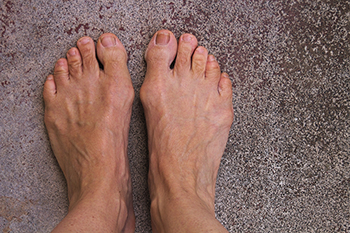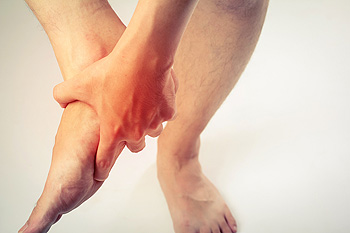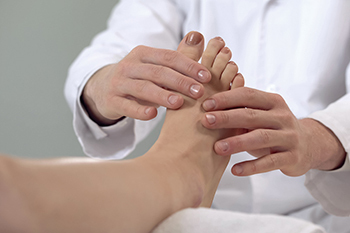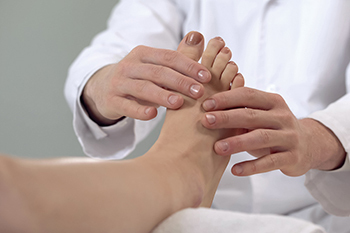Blog
Items filtered by date: September 2022
What Can Cause Bunions?

A bunion is a common foot condition that affects millions of people worldwide, and it is considered to be a deformity. Many people can develop a bunion from genetic reasons, or from wearing shoes that do not have enough room for the toes to move freely in. It is noticeable as a bony lump that gradually forms on the side of the big toe, and larger shoes may need to be purchased. If the bunion is large, it may cause the other toes to shift toward each other, which may result in pain and discomfort. Additional symptoms that can accompany a bunion can include calluses forming on the second toe, inflamed skin on the big toe, and the toes may be hard to move. There may be a decreased range of motion in the big toe, and patients may experience chronic pain. Mild relief may be found when the correct size and style shoes are worn, and a protective covering may be put over the bunion which may help to reduce friction. A podiatrist is qualified to diagnose and treat bunions, and it is strongly suggested that you confer with this type of doctor if you have this foot condition.
If you are suffering from bunion pain, contact Queen Mbanuzue, DPM of In Step Podiatry Center. Our doctor can provide the care you need to keep you pain-free and on your feet.
What Is a Bunion?
Bunions are painful bony bumps that usually develop on the inside of the foot at the joint of the big toe. As the deformity increases over time, it may become painful to walk and wear shoes. Women are more likely to exacerbate existing bunions since they often wear tight, narrow shoes that shift their toes together. Bunion pain can be relieved by wearing wider shoes with enough room for the toes.
Causes
- Genetics – some people inherit feet that are more prone to bunion development
- Inflammatory Conditions - rheumatoid arthritis and polio may cause bunion development
Symptoms
- Redness and inflammation
- Pain and tenderness
- Callus or corns on the bump
- Restricted motion in the big toe
In order to diagnose your bunion, your podiatrist may ask about your medical history, symptoms, and general health. Your doctor might also order an x-ray to take a closer look at your feet. Nonsurgical treatment options include orthotics, padding, icing, changes in footwear, and medication. If nonsurgical treatments don’t alleviate your bunion pain, surgery may be necessary.
If you have any questions, please feel free to contact our office located in Lanham, MD . We offer the newest diagnostic and treatment technologies for all your foot care needs.
What Is Morton’s Toe?

Morton’s toe is a foot condition that is obvious as the second toe is longer than the first toe, or big toe. Research has indicated it affects approximately ten percent of the population, and may cause foot pain. Many people may refer to this ailment as Greek toe, and this is a common sight on classic Greek sculptures. Morton’s toe develops from purely genetic reasons, and it is determined by the long bones in the foot, which are called the metatarsal bones. Pain may gradually develop during the beginning stages of taking a step, and this is the result of pressure that is exerted on the longest toe, which is the second toe in patients who have this condition. It can cause the foot to roll excessively inward, and may be controlled by wearing custom-made orthotics. Mild relief may be found when shoes a half size larger are selected, and this may help to diminish some of the pressure. If you have Morton’s toe, and are experiencing foot pain, it is suggested that you consult with a podiatrist who can help you to manage this foot condition.
Foot Pain
Foot pain can be extremely painful and debilitating. If you have a foot pain, consult with Queen Mbanuzue, DPM from In Step Podiatry Center. Our doctor will assess your condition and provide you with quality foot and ankle treatment.
Causes
Foot pain is a very broad condition that could be caused by one or more ailments. The most common include:
- Bunions
- Hammertoes
- Plantar Fasciitis
- Bone Spurs
- Corns
- Tarsal Tunnel Syndrome
- Ingrown Toenails
- Arthritis (such as Gout, Rheumatoid, and Osteoarthritis)
- Flat Feet
- Injury (from stress fractures, broken toe, foot, ankle, Achilles tendon ruptures, and sprains)
- And more
Diagnosis
To figure out the cause of foot pain, podiatrists utilize several different methods. This can range from simple visual inspections and sensation tests to X-rays and MRI scans. Prior medical history, family medical history, and any recent physical traumatic events will all be taken into consideration for a proper diagnosis.
Treatment
Treatment depends upon the cause of the foot pain. Whether it is resting, staying off the foot, or having surgery; podiatrists have a number of treatment options available for foot pain.
If you have any questions, please feel free to contact our office located in Lanham, MD . We offer the newest diagnostic and treatment technologies for all your foot care needs.
Are You Suffering From Nerve Damage?
Reasons for Ankle Pain

Ankle pain can be a result of a sprain, rolling the ankle, arthritis, gout, nerve damage, injury, blocked blood vessels, or infection in the joint. An ankle sprain is the most common cause of ankle pain, and is often caused by rolling or twisting the ankle so that the outside of the ankle moves towards the ground. With a sprain, the ligaments of the ankle holding bones together can get strained or torn. Arthritis - especially osteoarthritis - can also cause pain and inflammation of the joint because it causes wear and tear on the joint. Immediate action to take for ankle pain is rest and elevation of the foot. Compression of the ankle may also help. When the pain subsides, it is a good idea to exercise the ankle by rotating it in circles and flexing it up and down, which can help improve range of motion and reduce swelling. If these actions do not stop the pain completely and/or if there is extreme swelling or bruising, it is time to see a podiatrist for a diagnosis and treatment options.
Ankle pain can have many different causes and the pain may potentially be serious. If you have ankle pain, consult with Queen Mbanuzue, DPM from In Step Podiatry Center. Our doctor will assess your condition and provide you with quality foot and ankle treatment.
Ankle pain is any condition that causes pain in the ankle. Due to the fact that the ankle consists of tendons, muscles, bones, and ligaments, ankle pain can come from a number of different conditions.
Causes
The most common causes of ankle pain include:
- Types of arthritis (rheumatoid, osteoarthritis, and gout)
- Ankle sprains
- Broken ankles
- Achilles tendinitis
- Achilles tendon rupture
- Stress fractures
- Tarsal tunnel syndrome
- Plantar fasciitis
Symptoms
Symptoms of ankle injury vary based upon the condition. Pain may include general pain and discomfort, swelling, aching, redness, bruising, burning or stabbing sensations, and/or loss of sensation.
Diagnosis
Due to the wide variety of potential causes of ankle pain, podiatrists will utilize a number of different methods to properly diagnose ankle pain. This can include asking for personal and family medical histories and of any recent injuries. Further diagnosis may include sensation tests, a physical examination, and potentially x-rays or other imaging tests.
Treatment
Just as the range of causes varies widely, so do treatments. Some more common treatments are rest, ice packs, keeping pressure off the foot, orthotics and braces, medication for inflammation and pain, and surgery.
If you have any questions, please feel free to contact our office located in Lanham, MD . We offer the newest diagnostic and treatment technologies for all your foot care needs.
Foot and Ankle Injuries in Ballet Dancers

Foot and ankle injuries are sometimes an unavoidable part of a dancer’s life, and particularly so for ballet dancers. Overuse injuries are more common in ballet than traumatic injuries, as they can be attributed to repetitive movements and extraordinary stress on bones and soft tissue structures. Achilles tendinopathy is one example of this type of injury. This is often the result of excessive stress on the Achilles tendon due to exaggerated positions such as demi-plié, demie point, and en pointe. Flexor hallucis longus tendinopathy is an overuse injury that can occur from repeated pushing off from the big toe. The pirouettes ballet dancers perform put an incredible amount of pressure on the forefoot, which can cause a nerve disorder called Morton’s neuroma. Landing after jumps and rolling the foot down from demie point places repeated tension on the plantar fascia tissue on the sole of the foot. This can cause the tissue to become inflamed or torn (plantar fasciitis). A podiatrist has immeasurable experience in diagnosing and treating foot and ankle conditions of all kinds, and should be consulted for any such injury a dancer or athlete may incur.
Sports related foot and ankle injuries require proper treatment before players can go back to their regular routines. For more information, contact Queen Mbanuzue, DPM of In Step Podiatry Center. Our doctor can provide the care you need to keep you pain-free and on your feet.
Sports Related Foot and Ankle Injuries
Foot and ankle injuries are a common occurrence when it comes to athletes of any sport. While many athletes dismiss the initial aches and pains, the truth is that ignoring potential foot and ankle injuries can lead to serious problems. As athletes continue to place pressure and strain the area further, a mild injury can turn into something as serious as a rupture and may lead to a permanent disability. There are many factors that contribute to sports related foot and ankle injuries, which include failure to warm up properly, not providing support or wearing bad footwear. Common injuries and conditions athletes face, including:
- Plantar Fasciitis
- Plantar Fasciosis
- Achilles Tendinitis
- Achilles Tendon Rupture
- Ankle Sprains
Sports related injuries are commonly treated using the RICE method. This includes rest, applying ice to the injured area, compression and elevating the ankle. More serious sprains and injuries may require surgery, which could include arthroscopic and reconstructive surgery. Rehabilitation and therapy may also be required in order to get any recovering athlete to become fully functional again. Any unusual aches and pains an athlete sustains must be evaluated by a licensed, reputable medical professional.
If you have any questions please feel free to contact our office located in Lanham, MD . We offer the newest diagnostic and treatment technologies for all your foot and ankle needs.
Blog Archives
- January 2025
- December 2024
- November 2024
- October 2024
- September 2024
- August 2024
- July 2024
- June 2024
- May 2024
- April 2024
- March 2024
- February 2024
- January 2024
- December 2023
- November 2023
- October 2023
- September 2023
- August 2023
- July 2023
- June 2023
- May 2023
- April 2023
- March 2023
- February 2023
- January 2023
- December 2022
- November 2022
- October 2022
- September 2022
- August 2022
- July 2022
- June 2022
- May 2022
- April 2022
- March 2022


